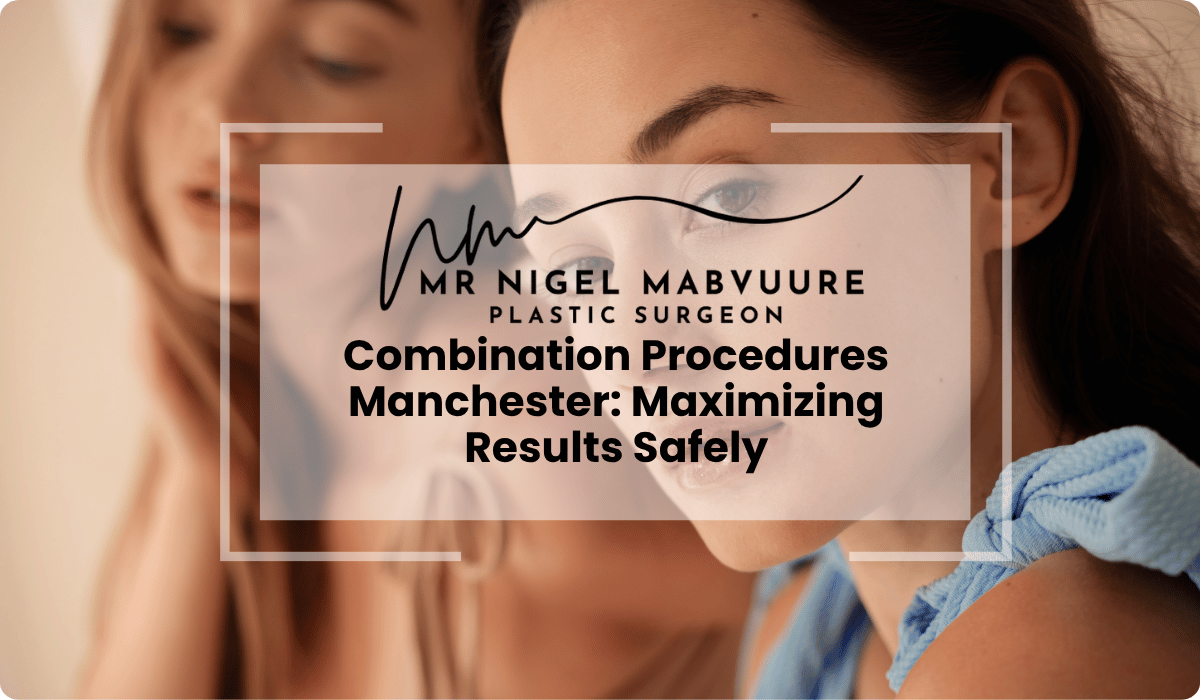Key Takeaways
- Combination plastic surgery offers efficiency benefits including reduced overall recovery time, cost savings, and single anaesthesia exposure.
- Popular safe combinations include “Mummy Makeovers” (abdominoplasty with breast surgery), facial rejuvenation packages, and complementary body contouring procedures.
- Safety considerations include limiting surgical time to 6-7 hours, careful patient selection, and assessing the extent of tissue manipulation.
- Surgery staging is based on scientific principles of the body’s healing capacity, inflammatory response, and recovery physiology.
- Recovery from combination procedures follows a predictable timeline spanning from immediate post-operative care to complete recovery over 3-12 months.
- Manchester’s approach to multi-procedure transformations emphasizes personalized planning, advanced techniques, and comprehensive post-operative support.
Table of Contents
- Understanding Combination Plastic Surgery: Benefits and Considerations
- Which Procedures Can Be Safely Combined in One Surgery?
- Is It Safe to Undergo Multiple Procedures Simultaneously?
- The Science Behind Staging Multiple Surgeries Effectively
- Planning Your Comprehensive Makeover: Consultation to Recovery
- Recovery Timeline for Combined Plastic Surgery Procedures
- Manchester’s Approach to Multi-Procedure Transformations
Understanding Combination Plastic Surgery: Benefits and Considerations
Combination plastic surgery refers to undergoing multiple cosmetic procedures during a single surgical session. This approach has gained significant popularity in Manchester and throughout the UK for its efficiency and comprehensive results. When carefully planned and executed by qualified surgeons, combination procedures can transform multiple areas of concern simultaneously, offering patients a more harmonious outcome.
The primary benefits of combination surgery include reduced overall recovery time, cost efficiency, and a single exposure to anaesthesia. Rather than recovering from multiple separate surgeries over months or years, patients can address several concerns at once. Additionally, certain procedures naturally complement each other, creating more balanced aesthetic results than when performed individually.
However, combination plastic surgery requires thoughtful consideration. The cumulative surgical time, complexity of recovery, and potential for complications must be carefully weighed against the benefits. Not every patient is an ideal candidate for multiple simultaneous procedures, which is why a thorough consultation with a specialist plastic surgeon is essential to determine the most appropriate surgical plan based on your health status, aesthetic goals, and recovery capabilities.
Which Procedures Can Be Safely Combined in One Surgery?
Certain plastic surgery procedures naturally complement each other and can be safely performed together when planned appropriately. In Manchester, our surgeons regularly combine procedures that target related areas or address complementary concerns.
Body contouring combinations are particularly popular, especially the “Mummy Makeover” which typically includes abdominoplasty (tummy tuck) with breast surgery (augmentation, lift, or reduction). This combination effectively addresses the common post-pregnancy concerns in a single recovery period. Liposuction is frequently added to enhance body contour results.
Facial rejuvenation combinations often include facelift procedures paired with blepharoplasty (eyelid surgery) or brow lifts. These combinations create a more harmonious facial appearance than addressing just one facial area. Rhinoplasty can sometimes be combined with chin augmentation to improve facial balance and profile.
Breast procedures are commonly combined, such as breast augmentation with a lift (mastopexy-augmentation) to address both volume and position concerns simultaneously. For body contouring, thigh lifts and arm lifts can be performed together for patients who have experienced significant weight loss.
The key factor in determining which procedures can be safely combined is the total surgical time, the amount of tissue being manipulated, and the patient’s overall health status. Generally, procedures should not exceed 6-7 hours of operating time to minimise risks associated with prolonged anaesthesia.
Is It Safe to Undergo Multiple Procedures Simultaneously?
The safety of undergoing multiple plastic surgery procedures simultaneously depends on several critical factors. For healthy patients, combination surgery can be performed safely when conducted by experienced surgeons in appropriate facilities with proper pre-operative assessment.
Research indicates that the risk of complications increases when surgical time exceeds 6-7 hours. Therefore, the combined duration of all procedures is a primary consideration. Your surgeon will carefully evaluate the total expected surgical time when planning combination procedures.
Patient selection is crucial for safety in combination surgeries. Ideal candidates are non-smokers in good general health, with stable weight and realistic expectations. Patients with significant medical conditions such as uncontrolled diabetes, heart disease, or clotting disorders may not be suitable candidates for multiple simultaneous procedures.
The amount of tissue manipulation and blood loss are also important safety considerations. Procedures involving extensive tissue removal or manipulation in multiple body areas may increase risks. Your surgeon will assess whether your desired combination of procedures can be performed safely based on these factors.
In some cases, a staged approach may be recommended instead of performing all desired procedures simultaneously. This decision is made based on the surgeon’s assessment of what will provide the safest outcome while still achieving your aesthetic goals. Safety always takes precedence over convenience in plastic surgery planning.
The Science Behind Staging Multiple Surgeries Effectively
Surgery staging is a strategic approach to planning multiple plastic surgery procedures when performing them simultaneously would exceed safe limits. This scientific approach considers the body’s healing capacity, anaesthesia exposure, and optimal aesthetic outcomes.
The body’s inflammatory response to surgery is a critical factor in staging decisions. Each surgical procedure triggers an inflammatory cascade that mobilises healing resources. When too many areas are operated on simultaneously, the body’s healing capacity can be overwhelmed, potentially compromising results and increasing complication risks. Staging allows complete healing between procedures, optimising outcomes for each intervention.
Blood loss is another scientific consideration. Multiple simultaneous procedures can lead to cumulative blood loss that may necessitate transfusion. By staging surgeries, the body can replenish blood volume and haemoglobin levels between operations, reducing transfusion risks.
Anaesthesia exposure is carefully managed through staging. Prolonged anaesthesia increases risks of respiratory complications, deep vein thrombosis, and other systemic issues. Limiting anaesthesia time to under 6-7 hours per session maintains safety while still allowing for significant improvements.
Recovery physiology also influences staging decisions. The body requires adequate nutrition, rest, and mobility for optimal healing. When too many areas are healing simultaneously, patients may struggle with basic activities, potentially leading to complications like deep vein thrombosis or delayed wound healing. Staging allows focused recovery for each operative area.
Your surgeon will develop a staging timeline based on these scientific principles, typically allowing 3-6 months between major procedures to ensure complete healing and optimal results.
Planning Your Comprehensive Makeover: Consultation to Recovery
Planning a comprehensive makeover involving multiple procedures requires thorough preparation and a structured approach. The journey begins with an in-depth consultation with your plastic surgeon in Manchester, where you’ll discuss your aesthetic goals, medical history, and lifestyle factors that might influence your surgical plan.
During this initial consultation, your surgeon will perform a detailed physical assessment, examining the areas you wish to enhance. They will explain which procedures can safely be combined and which might need to be staged. Digital imaging may be used to visualise potential outcomes and set realistic expectations. This is the time to ask questions about recovery, risks, and expected results.
Pre-operative preparation is crucial for combination procedures. Your surgeon will provide specific instructions, which may include laboratory tests, adjusting medications, stopping smoking, and optimising nutrition. For extensive combination surgeries, you might need to arrange for assistance during recovery, prepare your home environment, and take sufficient time off work.
The surgical plan will detail the sequence of procedures, estimated surgical time, and anaesthesia approach. Your surgeon will coordinate with anaesthesiologists and surgical staff to ensure seamless execution of multiple procedures. The plan will also include contingencies should any adjustments be needed during surgery.
Post-operative care planning is particularly important for combination procedures. Your surgeon will provide detailed recovery instructions, medication schedules, and follow-up appointment timelines. They’ll also discuss the expected recovery progression and when you can gradually resume normal activities.
This comprehensive planning process ensures that your multiple-procedure transformation is performed safely while maximising aesthetic outcomes and minimising recovery challenges.
Recovery Timeline for Combined Plastic Surgery Procedures
Recovery from combination plastic surgery procedures follows a predictable timeline, though individual experiences may vary based on the specific procedures performed and personal healing factors. Understanding this timeline helps patients prepare mentally and logistically for their recovery journey.
The immediate post-operative period (1-7 days) typically involves the most discomfort and limited mobility. During this phase, patients require assistance with daily activities, medication management, and wound care. Swelling and bruising peak around day 3-4 and begin to subside thereafter. Drainage tubes may be present for the first few days, particularly after procedures like tummy tucks or extensive liposuction.
The early recovery phase (1-3 weeks) sees gradual improvement in comfort and mobility. Most patients can resume light activities and self-care, though strenuous activities remain restricted. Compression garments are typically worn continuously during this period to control swelling and support healing tissues. Follow-up appointments are frequent to monitor healing progress.
The intermediate recovery phase (3-6 weeks) brings significant reduction in swelling and increased energy levels. Many patients can return to non-strenuous work and social activities, though exercise remains limited to walking and gentle movement. Sensation changes are common during this period as nerves regenerate.
The advanced recovery phase (6-12 weeks) allows resumption of most normal activities, including moderate exercise. Residual swelling continues to resolve, and results become increasingly apparent. Scars begin to mature and fade, though this process continues for many months.
Complete recovery (3-12 months) sees the final resolution of swelling, scar maturation, and settling of tissues into their final position. Patients can enjoy their full results and resume all activities without restriction. Follow-up appointments become less frequent but remain important for monitoring long-term outcomes.
This extended recovery timeline highlights the importance of patience when undergoing combination procedures. The comprehensive transformation is worth the investment of time in proper healing.
Manchester’s Approach to Multi-Procedure Transformations
Manchester has established itself as a centre of excellence for combination plastic surgery procedures, with specialist surgeons adopting a distinctive approach that prioritises both safety and outstanding aesthetic outcomes. The Manchester approach is characterised by meticulous planning, personalised care, and the integration of advanced surgical techniques.
Surgeons in Manchester emphasise comprehensive pre-operative assessment, utilising advanced imaging technology and detailed consultations to create bespoke surgical plans. This thorough preparation ensures that combination procedures are tailored to each patient’s unique anatomy and aesthetic goals, rather than applying a one-size-fits-all approach.
The Manchester technique for combination surgeries often incorporates minimally invasive methods where appropriate, reducing recovery time and scarring. This approach is particularly valuable when multiple areas are being addressed simultaneously. Manchester surgeons are adept at combining traditional surgical techniques with newer, less invasive options to optimise results while minimising downtime.
Post-operative care is another hallmark of the Manchester approach. Patients undergoing multiple procedures receive enhanced recovery protocols, including detailed aftercare instructions, regular follow-up appointments, and access to dedicated recovery specialists. This comprehensive support system ensures optimal healing and results.
Manchester’s plastic surgery community maintains strong connections with international centres of excellence, regularly incorporating the latest evidence-based practices into their combination surgery protocols. This commitment to continuous improvement ensures that patients benefit from the most advanced and safest techniques available.
The city’s plastic surgery clinics also offer integrated recovery facilities, allowing patients undergoing extensive combination procedures to receive specialised care during the critical initial recovery period. This holistic approach to patient care has contributed to Manchester’s reputation as a preferred destination for those seeking comprehensive aesthetic transformations.
Frequently Asked Questions
How long does recovery take after multiple plastic surgery procedures?
Recovery from multiple procedures follows a progressive timeline: 1-7 days of intensive recovery requiring assistance, 1-3 weeks of limited activity while wearing compression garments, 3-6 weeks for significant swelling reduction, 6-12 weeks to resume moderate exercise, and 3-12 months for complete healing with final results. The specific timeline varies based on procedures performed and individual healing factors.
What is the maximum number of plastic surgery procedures that can be done at once?
There is no fixed maximum number of procedures; instead, safety is determined by total surgical time (ideally under 6-7 hours), extent of tissue manipulation, blood loss, and the patient’s overall health. Your surgeon will assess these factors to determine whether your desired procedures can be safely combined or should be staged across multiple surgeries.
Is combination plastic surgery more cost-effective than separate procedures?
Yes, combination surgery is typically more cost-effective than separate procedures. You’ll pay for operating room time, anesthesia, and facility fees once rather than multiple times. Additionally, you’ll need only one recovery period, reducing time off work and caregiving expenses. However, the primary consideration should always be safety rather than cost savings.
Who is not a good candidate for multiple procedures at once?
Poor candidates for combination surgery include patients with significant medical conditions (uncontrolled diabetes, heart disease, clotting disorders), smokers who cannot quit, those with BMI over 30, patients with unrealistic expectations, and individuals without adequate support during recovery. Age alone isn’t disqualifying, but older patients require more thorough health assessments.
How do surgeons determine which procedures to combine versus stage?
Surgeons determine combination versus staging based on: total expected surgical time (keeping under 6-7 hours), anatomical relationships between procedure areas, extent of tissue manipulation, estimated blood loss, recovery complexity, and the patient’s health status. Procedures in related anatomical areas that complement each other aesthetically are more likely to be combined.
What are the risks specific to undergoing multiple procedures simultaneously?
Risks specific to multiple simultaneous procedures include: prolonged anesthesia exposure, increased blood loss, greater inflammatory response, more complex recovery management, higher risk of venous thromboembolism due to extended immobility, nutritional challenges during healing, and potential compromise of results if the body’s healing capacity is overwhelmed. These risks must be balanced against the benefits of a single recovery period.




